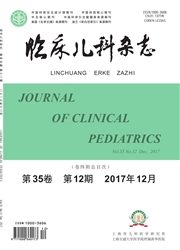

 中文摘要:
中文摘要:
目的探讨新生儿Wiskott-Aldrich综合征(WAS)的临床特征和基因诊断。方法分析3例患儿的临床表现,采用Sanger测序方法进行WAS蛋白(WASP)基因突变分析,并结合相关文献总结WAS的临床特征、基因诊断。结果 3例患儿均在出生后不久即出现血小板计数减少伴体积减小,1例患儿有败血症,3例均无湿疹。3例患儿均检测到WASP基因的纯合突变,2例为无义突变,1例为错义突变;3例患儿的母亲均为相应位点的杂合突变,证实为携带者。结论新生儿WAS常不出现典型的湿疹、血小板减少、免疫缺陷三联征。对不明原因血小板减少,尤其是伴血小板体积减小的患儿,应行WASP基因分析,有助于WAS的诊断。
 英文摘要:
英文摘要:
Objective To investigate the clinical characteristics and genetic diagnosis of neonatal Wiskott-Aldrich syndrome(WAS). Methods The clinical characteristics of 3 cases of WAS were analyzed. The WASP gene mutations was analyzed by Sanger sequencing method. The related literatures were reviewed to summarize the clinical characteristics, diagnosis, and prognosis of WAS. Results All three cases of WAS had postnatal thrombocytopenia, accompanying platelet volume decrease. One case suffered from sepsis. Three cases did not suffer from eczema. Three cases were detected WASP homozygotic mutations, 2 cases had WASP nonsense mutations, and one case had WASP missense mutations. Their mothers also had heterozygous mutations at the corresponding loci, and were confirmed as carriers. Conclusions Neonatal WAS often do not have typical triad, eczema, thrombocytopenia, and immunodeficiency. For neonatal with idiopathic thrombocytopenia, especially with the decrease of platelet volume, the WASP gene analysis should be performed to diagnose WAS.
 同期刊论文项目
同期刊论文项目
 同项目期刊论文
同项目期刊论文
 期刊信息
期刊信息
